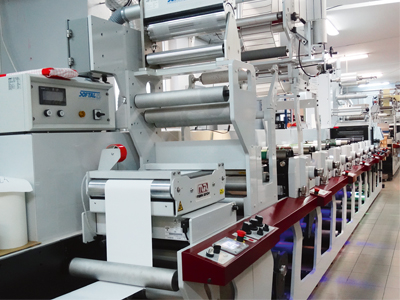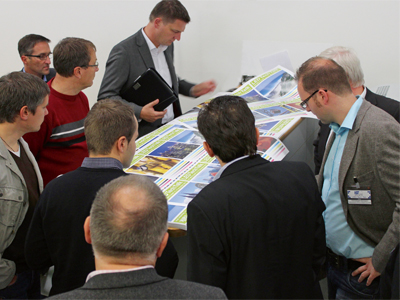Printed samples were produced at the IST seminar
Curing with UV LED is an emerging technology that is slowly gaining momentum in the flexographic print industry. By Neel Madsen.
As reported in the last issue, there are major initiatives taking place with suppliers working together to further the understanding of the productivity improvements UV LED curing can offer. However, opinions are still divided on whether the technology is commercially viable at the present time.
Being prepared
In November last year, IST Metz GmbH held a seminar to debate UV LED technology and its application. This looked at the differences between conventional and UV LED curing and importantly asked the question ‘When is it worth switching?’ The company’s MBS-6 LED-prepared concept was also demonstrated on a narrow web flexo press.
Stefan Feil, technical marketing manager, said that in 2014 for the first time, partner company Integration Technology Ltd, with whom IST Metz has entered into a strategic alliance, sold an equal number of systems with UV lamps and LEDs.
He also addressed the possibility of saving energy, explaining that the more highly reactive ink does mean that energy savings are possible in principle. A comparison would have to take into account that UV LED systems also change the chemistry of the inks. ‘An effective comparison needs to be made on the basis of a defined drying outcome, which in turn allows the necessary drying output to be derived. Standby/production times and average print format also have to be taken into account to make the result meaningful,’ concluded Mr Feil.
IST has designed the ‘LED-prepared’ concept to allow users to change over from the established UV technology to UV LED technology at short notice as and when the need arises. This is achieved by leaving the outer housing in situ and replacing the MBS-6 conventional unit with an equivalent UV LED cassette unit that simply slots into its place.
‘Companies planning on investing in new printing technology may will see themselves faced with a dilemma. Should they go for the conventional UV units and rely on the security provided by a long established technology? They may well miss their chance to make the most out of UV LED, however, users who focus on this new technology too soon, run the risk of paying dearly as they wait for the rest of the market to catch up,’ stated the company.
Collaboration needed
Founded in 1997 in the US, Air Motion Systems, Inc designs and manufactures advanced UV and UV LED curing systems and related technologies for the graphic arts and other industries.
For CEO Stephen Metcalf, UV LED has become both a passion and a mission. He said, ‘While the environmental and energy benefits grab the headlines from a consumer standpoint, it is the operational implications that are most exciting for the hands-on manufacturers I meet. We have had to be selective about the sectors we target for uptake of this technology; it requires collaboration with other suppliers as well as the customer to get the solution right.
‘In flexo printing, heat is an unwanted by-product of other UV processes – it is the wavelength of the light in relation to the inks or chemicals that performs the curing. By eliminating the heat, LED removes a whole raft of problems for flexo printing. This is probably the area of application that will most strikingly benefit from the special properties of UV LED.’
The company has recently installed a system on a flexo narrow web press at Italian printing company ACM srl.

UV LED curing system fitted on a Mark Andy P3 at KDS in Poland
Increasing speed
Phoseon Technology has been developing UV LED technology since 2002. Stacy Hoge, marketing communications, said, ‘UV LED curing systems are ideal for label and narrow web printers, enabling end users to print high quality material at maximum speeds. UV LED curing for label printing shows measurable advantages in higher productivity, lower energy usage, reduced heat load for thinner substrates, smaller footprints and clear environmental benefits. Being a solid-state device, UV LED systems are instant on/off with no warm-up time, and as there is no ozone creation, there is no need for air ducts or ventilation. All of this combined results in savings of up to 70% on electricity.’
The company’s FirePower product line allows new applications in the narrow and wide web segments while also offering increased speed in the flexo segment. The intense UV output (up to 20 W/cm2) paired with UV LED flexo inks have achieved record press speeds, said Ms Hoge. The low heat output of the FirePower has enabled new capabilities such as heat sensitive materials, unsupported films and thinner substrates.
Phoseon has just announced the official opening of its Tokyo office and the appointment of Kazuhiro Tanaka as the general manager of Phoseon-Japan. It has also expanded its executive team with the appointment of John North as vice president of worldwide sales.
LED inks
Dedicated UV LED inks are required for the process and manufacturers are developing new products for this market.
In September 2013, Flint Group Narrow Web won the award for innovation at The Label Industry Global Awards for its EkoCure UV LED flexo ink technologies. It was named joint winner alongside co-supplier and development partner, Mark Andy. EkoCure inks are now globally available and include products for rotary screen whites, various coatings and adhesives, and flexo shrink whites, amongst others.
Paragon Inks in the UK has released an ultra low migration (ULM) LED range. This meets all the requirements of 10 ppb low migration, low odour and low taint. Based on high quality European grade materials, the range offers high strength, fast curing at speeds of up to 180 m/min.
The company works closely with key OEMs, co-suppliers and customers to bring the market the next generation of energy curable ink and coating systems. It sees UV LED inks and coatings as the next rung in the ladder with regards to technology, bringing the printer and converter not only cost savings but flexibility of converting both supported and unsupported applications.
In the field
Mark Andy has been a trailblazer in adopting the technology, working in partnership with Phoseon Technology to develop UV LED curing for its narrow web presses. Its ProLED technology won the FlexoTech award for innovation in 2013.
KDS, one of Poland’s fastest growing label converters, is an early adopter, having recently invested in UV LED technology for its new Mark Andy P3 Performance Series press. The P3 is the company’s first 330 mm wide press, and the new seven colour flexo line is already earning its living printing paper and filmic labels at 150 m/min using 70% of maximum lamp output.
The low running temperature of the UV LED system means that filmic substrates can be handled easily without chill drums. The new curing system has also reduced electricity consumption, and KDS estimates it is currently saving at least €2000 per month.
According to owner, Tomasz Dabrowski, the choice of Paragon Inks was critical to allowing the press to run at high speed without splash or foaming. Although more expensive than conventional UV inks, they have higher pigmentation that allows KDS to run a lower volume anilox to reduce consumption.
And in Mexico, Etiquetas e Impresiones has purchased a Mark Andy Performance Series P5 eight colour press with the ProLED UV curing system, to service its customers in the food, beverage and industrial products sectors in northern Mexico and the south-west of America.
Viable or not?
GEW (EC) Limited has been engaged in researching the potential of UV LEDs for many years. Malcolm Rae, managing director, said that to correctly understand the possibilities and potential pitfalls of LEDs a closer examination of the technology is essential. ‘At 25% to 30 %, the percentage of electrical energy converted to UV radiation by an LED is actually very similar to that of an arc lamp. The total power requirement for an LED system is also very similar to that of an arc lamp solution at around 100 W/cm.’
‘It is true that LEDs are substantially more efficient than older UV systems, but the differences compared to modern arc lamp systems in operation are minimal,’ he continued. ‘The real energy advantage for LEDs is that they switch on and off instantly. This reduces the non-production energy consumption significantly and can make LEDs an attractive energy saving alternative in environments with short production runs and high standby cycles.’
The second important consideration is lifetime cost efficiency. LED arrays potentially last over 20,000 hours, about seven to 10 times longer than an arc lamp. ‘But it is important to remember that a replacement LED array can cost around 15 times more than all the equivalent lamps over the same period,’ continued Mr Rae.
‘However,’ he concluded, ‘the costs of LED inks and curing systems are likely to come down and the performance of both will increase further. Today LEDs are a more expensive alternative but if current trends continue, they will become an attractive proposition in the future.’
Mark Loveridge, from UV lamp manufacturer Alpha-Cure, also questioned the benefits at the current time, saying that at the moment UV LED may be suitable only for some very narrow applications, but added, ‘We will embrace LED as soon as it becomes available at the right price, with the right performance and a greater range of good value inks.’
Testing
For proofing off press, RK Printcoat Instruments has developed a compact UV LED curing system, which can be integrated with the company’s FlexiProof. Tom Kerchiss, managing director, said that the new system is an optional alternative to the dichroic mercury arc vapour lamps currently provided with the FlexiProof. The lamps integrated in the FlexiProof offer a tailored output at 385 or 395 nm wavelength.
GEW has launched a new, faster version of its LED UV curing lab system, which incorporates the same curing module designed for full production printing and coating applications, to reflect actual production scenarios. The ‘Magic Carpet’ LED lab system makes the task of developing and testing new UV LED ink formulations easy, accurate and ergonomic. It has a maximum curing power of 18 W/cm² and run speed of up to 100 m/min.






